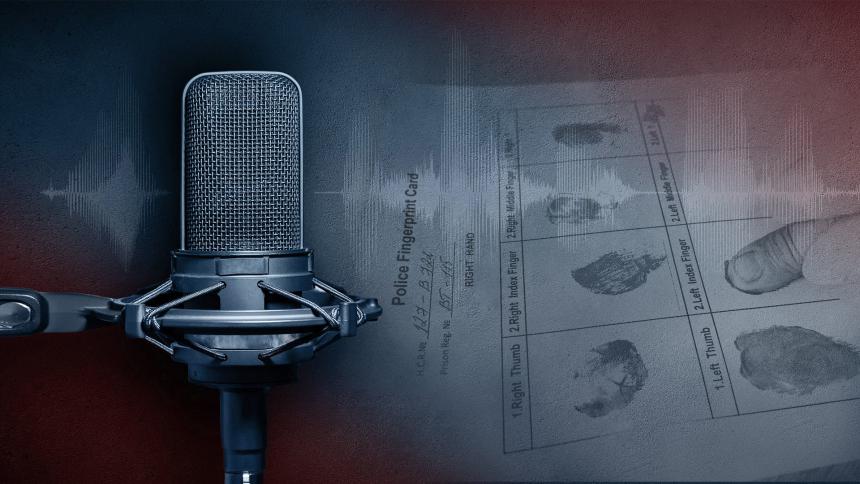
8 true crime podcasts that helped crack real life crimes
Perhaps the single most popular podcast genre is true crime. Tales of murder and mysterious disappearances have dominated the medium for years, with some of the more popular shows having been downloaded hundreds of millions of times.
Their objective is to educate and entertain. And, of course, to try and make a little money for those writing, producing, and releasing them. There is, however, very often an additional goal...to crack an unsolved criminal case.
These are the stories of eight podcasts that uncovered vital new evidence that either directly or indirectly solved a real-life case.
1. The murder of Hae Min Lee – Serial
Hae Min Lee disappeared at 3pm on 13th January 1999. After she didn't pick up her niece from school as promised, her family reported the 18-year-old high school student missing. Lee's body was discovered four weeks later, half buried, in Leakin Park in West Baltimore. She'd been strangled to death.
On 1st March, police arrested Lee's ex-boyfriend, Adnan Syed. Prosecutors claimed that Syed murdered her after becoming enraged that she was seeing someone else. Syed pled not guilty and his first trial resulted in a mistrial. He was, however, later convicted of kidnapping and first-degree murder in February 2000. He was sentenced to life in prison plus an additional 30 years.
Syed had been behind bars ever since. However, that changed very recently, largely thanks to the most famous true crime podcast of all, Serial.
Across a dozen episodes, the podcast's presenter - journalist Sarah Koenig - forensically investigated the case and concluded that Syed was most likely innocent. The sheer weight of attention on the case eventually led to it being looked into again and Adnan Syed was acquitted due to insufficient evidence. He had served 23 years in jail.
2. The disappearance of Tara Grinstead - Up and Vanished
The killer and their accomplice had surely thought they’d gotten away with the murder of former beauty queen and teacher, Tara Grinstead. The 30-year-old Georgia native was reported missing in October 2005 and declared dead in absentia five years later. With no clues or leads, it seemed likely that Tara’s missing person case, like so many others, would remain unsolved.
Enter Payne Lindsey and his Up and Vanished true crime podcast.
August 2016 saw the release of the first season. Its entire 25-part run was dedicated to the case, along with many bonus episodes, Q&As, and phone-in shows. Payne went deep into the case and took millions of fans down the rabbit hole with him.
Eventually, Ryan Alexander Duke was arrested, tried, and convicted for Tara's murder, with his friend, Bo Dukes, charged with helping cover it up. Georgia Police specifically thanked Payne for shedding new light on the case and reigniting the public’s interest.
3. The rape and murder of Helene Pruszynski - The Murder Squad
Until very recently, retired cold case investigator Paul Holes and investigative journalist Billy Jensen hosted one of the world's most popular true crime podcasts. A behemoth in its lane, The Murder Squad was unique in that it sought to build a community of likeminded amateur sleuths and hoped to crack cases itself.
The duo encouraged their listeners to submit their DNA to the GEDmatch database in the hope that it would aid in the resolution of some of the cases the podcast looked into. This bold strategy led to the identification of the killer of Helene Pruszynski.
In June 2019, a listener going by the name Jessi uploaded a DNA sample to the database. Soon, she received a call from the police, informing her that her DNA matched a suspect in the 1980 Pruszynski case, James Curtis Clanton, her third cousin. Clanton was eventually tried and convicted, in part because of Jessi’s contribution.
4. The murder of Courtney Coco - Real Life, Real Crime
Woody Overton, host of the award-winning true crime podcast Real Life, Real Crime, began investigating the murder of Courtney Coco in Alexandria, Louisiana in October 2004. As an ex-cop, he knew that people with useful information were often reluctant to share their insider info with law enforcement. So he established a private hotline where individuals could call in anonymous tips and any other information they thought might be useful.
Overton and his team got multiple calls about the Coco case, one of which proved pivotal in solving the crime. Overton's idea led to the arrest of Anthony Burns for Courtney Coco's murder.
5. The disappearance of Kristin Smart - Your Own Backyard
Chris Lambert, a musician, decided to pivot his career in September 2019 and began publishing a 10-part podcast series called Your Own Backyard. The true crime podcast went into considerable detail about Kristin Smart's abduction from the campus of California Polytechnic State University back in May 1996.
The podcast became a major hit, with over five million downloads in the first six months alone. Renewed public interest resulted in the installation of a brand new billboard about Kristin in Arroyo Grande, California just three months later. This was encouraging news for Kristin's friends and family, but Lambert's inquiry eventually yielded even better results.
On 13th April 2021, the San Luis Obispo County sheriff publicly revealed that two arrests had been made in the case of Kristin Smart's disappearance. He went on to thank Your Own Backyard, adding that the podcast had encouraged witnesses to come forward with new information, resulting in the necessary break in the case.
Paul Flores, 45, was charged with murder, while his father, 81-year-old Ruben Flores, was charged with being an accessory.
6. The murder of Lynette Dawson – The Teacher’s Pet
The disappearance and assumed murder of Lynette Dawson was one of the coldest of cold cases before the popularity of The Teacher’s Pet podcast helped reignite worldwide interest. Lynette, who lived close to Sydney, had gone missing way back in 1982 and her husband, Chris Dawson, claimed that marital discord had caused her to abandon him and their two children.
Chris Dawson, a schoolteacher who married his teenage lover soon after Lynette vanished, was long considered the prime suspect in the case, but a frustrating lack of concrete evidence allowed him to evade prosecution for decades. Then, in 2018, journalist Hedley Thomas launched The Teacher’s Pet, a podcast which delved into the case and its sordid context, laying bare a culture of sexual misconduct at Dawson’s school.
The podcast was a smash hit, and that same year Dawson was arrested and charged with murder – a result which led Lynette’s brother to thank Hedley Thomas for shining the spotlight on the case. Indeed, a police source told Australian media that public interest brought about by the podcast was ‘100 per cent’ behind the fresh investigation which led to the arrest and trial.
Such was the influence of The Teacher’s Pet that Dawson’s lawyers tried to have the case thrown out by claiming the podcast jeopardised his chance of a fair trial. He was eventually handed a 24-year sentence for the callous murder of his wife.
7. The Bear Brook murders – Bear Brook
Hosted by Jason Moon, the Bear Brook true crime podcast probed one of the murkiest murder cases in New Hampshire history, stemming back to the 1985 discovery of two bodies buried in a barrel in Bear Brook State Park. Over 15 years later, two more bodies were found in a second barrel – in all, the corpses of one adult woman and three young children made up the grisly tally.
Jason Moon started covering the case in 2015, as authorities were creating forensic reconstructions of the victims’ faces. DNA analysis ascertained that the woman was the mother of two of the girls. Another breakthrough came in 2017 when detectives tied the barrel murders to another killing that had occurred in 1981. This in turn led to the culprit being identified as Terry Rasmussen, who had died in prison in 2010 while serving a life sentence for murdering his wife.
However, the identities of the Bear Brook victims were still unknown. This is where the true crime podcast played a crucial role, inspiring armchair sleuths to dig through cases of missing persons to pinpoint those who could have fallen foul of Rasmussen.
One such sleuth was research librarian and avid podcast fan Rebekah Heath, who had previously spotted an ad posted on Ancestry.com asking for help finding a young girl named Sarah, who had gone missing in the late 1970s in the same region Rasmussen had lived. Digging deeper, Rebekah found more posts which revealed that Sarah, her sister Marie, and their mother, Marlyse Honeychurch, had all gone missing in the same region, around the same time.
Rebekah knew they fitted the profiles of three of the bodies found in the barrels, but it was only after listening to the Bear Brook podcast that she felt spurred to contact one of the relatives. They confirmed the connection by saying that Marlyse had married someone named Rasmussen.
Stunned that she had managed to crack the case, Rebekah notified the police, who were able to confirm the names using DNA profiling in 2019. It was a miraculous moment long in the making, although the name of the fourth victim, believed to be Rasmussen’s own daughter, remains unknown.
8. The disappearance of Cleo Semaganis Nicotine – Missing & Murdered
It’s understandable that Missing & Murdered: Finding Cleo is categorised as a true crime podcast, given that its focus is the mysterious disappearance of a young girl.
But the enigma of Cleo Semaganis Nicotine is part of a larger investigation into Canada’s devastating ‘Sixties Scoop’ – a hugely misguided social programme which saw thousands of First Nations children unceremoniously taken from their communities and placed with non-Indigenous families across North America and beyond.
This blunt attempt to ‘solve’ welfare issues and force assimilation had terrible consequences for many of the displaced children. One of them was young Cleo, who in 1974 was whisked away from Little Pine First Nation in Saskatchewan and never seen again by her siblings, who had also been placed with different families.
Working alongside Cleo’s siblings, podcaster Connie Walker – herself of the Cree Indigenous people – pieced together the puzzle of the girl’s life. Was there any truth to the rumour she had been kidnapped and murdered while trying to hitchhike back from the United States?
The podcast investigation revealed Cleo’s fate was indeed tragic but in a different way. Raised by the Madonia family in New Jersey, she had been an outwardly well-adjusted and studious child but had yearned to return to her country and people. In December 1978, the 13-year-old Cleo shot herself with her adoptive father’s pistol.
Although it wasn’t the denouement that her family wanted, the solving of the case has served a deeper purpose of awakening a new generation to the Sixties Scoop and the hidden history of the First Nations children who fell afoul of an unfeeling policy.
Check out our true crime podcast hub for podcast features and interviews, plus full episodes of the Murdertown podcast.












